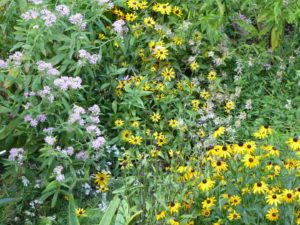
It’s just past Summer Solstice. Amidst Covid-19, the only celebrations many of us got to experience this year were virtual. When I participated in a recent online solstice ceremony the presenter asked me how I, as a fellow ceremonialist, celebrate Summer Solstice. I said there is no set, repeated ritual. It’s different every year. The rituals comprising the ceremony depend on what is going on in the community and in the natural world. A ceremony evolves based on what is most needed socially, ecologically, and spiritually. This year’s solstice needs to be about hope for the health of people and nature.
The crisis of Covid-19 is an aspect of the collapse of Earth’s systems that we have created. The pain of our bodies and the pain of the body of the Earth are intertwined. The pandemic has made us realize that in order for people to be healthy, wild animals have to be healthy; in order for us to breathe, we and the trees need to breathe fresh air. While air pollution is temporarily abated, the climate crisis is still to be faced. The precipitous loss of biodiversity continues as we debate what percentage of Earth’s ecosystems can and should be saved.
With the closure of gyms and the unavailability of other forms of recreation, people who have the luxury to do so have turned to walking in parks and making vegetable victory gardens. (My son calls his “Armagarden.”) I’d hoped the necessity to socially isolate would be an opportunity for people to return to communing deeply with nature. But the incredibly overdue focus on racial discrimination has brought to the fore the stunningly unequal access to nature that Black and Brown people experience and the fact that all of the land, therefore all of our public parks and gardens, were stolen from Native Americans and, here in the South, wrested from the hands of Black farmers. Racial equality, environmental justice, and equal rights to fulfill their lives for the plants and animals with whom we share the planet are all, increasingly obviously, interconnected.
Every public garden and every conservation organization I know of is making the link between white supremacy and environmental destruction. An article just out in Sierra Club states, “If climate change and environmental injustice are the result of a society that values some lives and not others, then none of us are safe from pollution until all of us are safe from pollution.”¹
So, I arrive at Solstice here in our gardens with the mutual health of nature, people and animals in mind. For a while now I have had a desire to make a ceremony to honor the pollinators. Now is the time. My concern for the plight of animals centers here on the alarming decline of insects, including the bees and butterflies, the pollinators of all of the wildflowers of our public lands and private gardens, and of all of our fruits and vegetables. These nourishers of both our bodies and our souls.
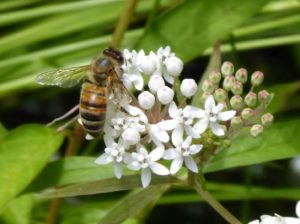
I first became interested in doing a pollinator ceremony about four years ago when we visited our cousin on the Lac Courte Oreilles Chippewa (Ojibwe) reservation in Wisconsin, and she showed us photos of her late mentor making a pollinator honoring ceremony. He is dancing, singing, a big monarch painted on his drum.
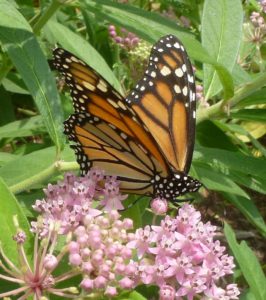
Around that time my husband and I had begun planting a large garden of native flowers to sustain the pollinators and have added more species every year. Along with the well-known plight of honey bees and monarchs, the news of the decline of insects has been very concerning. Studies are showing a worldwide diminishment of insects, both in abundance and diversity, of anywhere from 25 to 40 percent. The biggest causes are intensive agriculture, habitat loss, pesticides, herbicides, and climate change.²
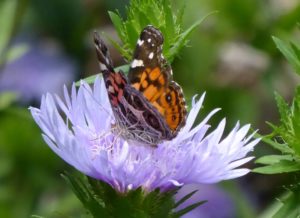
Although I am not feeling very hopeful about the health of the pollinators, I am choosing to create a ceremony based on hope for their recovery. I wholeheartedly agree with David Quammen³ who says, “Hope is not a psychological condition, it’s an act of will.” I always want to make celebrations of earth-spirit very particular to place, very appreciative of the local landscape, so I feel virtually supported in hearing that an upcoming online environmental education symposium (in Ireland) is called “Valuing Your Local Place in a Post-Covid World.” Because our own ceremony will be live, just a few of us masked and socially distanced humans will attend.
Last summer I was very worried about the lack of bees in the garden, especially honey bees. I’m grateful that this year the herbs – the lavender, lemon thyme, oregano, pink wild bergamot, white mountain mints, catnip, and yarrow – all are audibly alive with honey bees, and with bumble bees of every size.
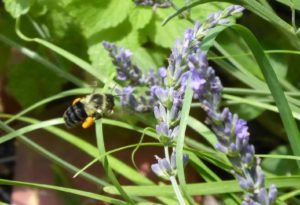
The blueberry bees obviously thronged here in spring; all the bushes are covered with berries. And whichever bees did all that pollinating, the elderberries are prolificating. The squash bees must have visited, too, because there are small yellow squashes forming. But, see all those cucumber flowers over there, and these tomatoes here, they need you, bees, to come to them too, please.
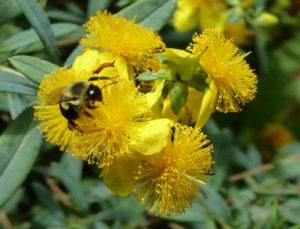
I’m always happy when I can include an animal or plant that is native to this local landscape in a celebration of the solar season. Last Summer Solstice we honored the golden sun-like globes of St. John’s Wort and the bees that flocked to collect their yellow pollen. St.John’s Wort is the traditional flower associated with St.John’s Day or Midsummer, as the solstice is called in Europe, and so by my ancestors. I am nourished when celestial, planetary significance joins with rooted, earthy substance, linking spirit and matter.
This year Summer Solstice is symbolized for me by the mid-June blooming of a sunflower relative, Silphium perfoliatum or Cup Plant. Its rays shine out from a central disk that is a favorite of bees who drink nectar and collect pollen as they speed around the little disk flowers in a wild circle dance. Cup plant grows locally along the sunny wooded edges beside streams. Birds drink water from the cups formed by the broad leaves that enclose the stem and eat its ripe seeds.
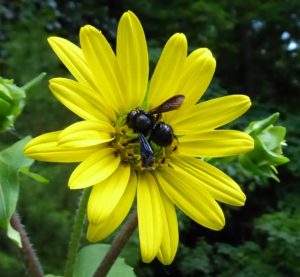
I was surprised to read that this Silphium is an excellent biofuel, a much more ecologically sustainable fuel plant than corn. It is a source of nutritious honey and has many medicinal and health enhancing properties. Witnessing its long, exuberant and prolific flowering, accompanied minute by minute by visits from various species of bees eager for its pollen, in the midst of this hard and necessary quarantine, has been very soothing for me, reassuring me that life goes on. Bumblebees of all sizes, mason bees, mining bees, little leaf-cutter bees, there are flowers for all of you.

Blessed be the flies who pollinate, too. Who knew? Syrphid flies and hover flies and metallic golden flies, please thrive. Other insects, like dragonflies can be “inadvertent pollinators.”
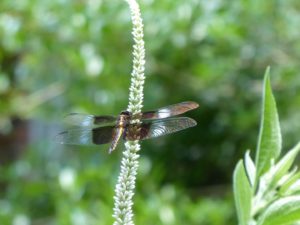
However, in the years since we began the pollinator garden, my notes and photos show many more butterflies arriving by now. The variegated fritillaries had already arrived in late May and made their babies on the leaves of the passionflower vines. The almost luridly passionate passionflowers are now blooming. I watch the big round carpenter bees, perfectly shaped to fit amongst the sexual parts, crawling around almost frantically, but I see no butterflies. And the fuzzy grey leaves of the pussytoes had already been stitched together with silk, cocoon-like, to snugly shelter the American painted lady caterpillars while they transformed. The vivid purple coneflowers and the feathery purple anise hyssop flowers had certainly welcomed more than one or two tiger swallowtails by this time.
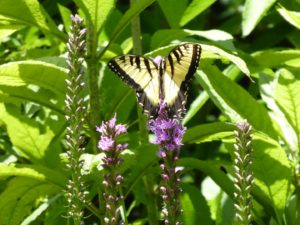
Listening closely I hear the pipevine climbing leisurely up the maple tree saying, “Look, pipevine swallowtails, see my leaves, these big green hearts, reaching out, waiting for you to flash your brilliant black and turquoise wings and place your babies’ eggs on us so we can nourish them.” The flowers of the fennel plants are reaching 10 feet high already calling, “Look here, look here, black swallowtails. Come place your young ones on us so they can munch our leaves and then transform.” And from the woods I hear, “What about all of us lush-leaved newly planted spicebushes, we are lonely for you, spicebush swallowtails.”
A chorus of voices shout, “Butterflies, come join this garden party. We flowers want you to sip our nectar. We empty leaves are bereft. Come join your community; you belong here. Perhaps our friends the bluebirds will nest again if you provide your caterpillars for their babies.”
Human gardener that I am I’m astounded by the beauty of the flowers. Sometimes I do nothing but sit and soak in the glory, but I am not satisfied with beauty alone. I want health, the health of the whole company of people and plants and insects. I need the companionship expressed by all these floral and faunal partners relating intimately. As Thomas Berry says, “Relationships are the primary context of existence.”
The bees start arriving as soon as the sun hits the flowers and dries the dew a bit. I go out in the morning to watch them, but the butterflies, when there are any, typically arrive when the sun climbs high and it’s hot. Might it be that I’m inside, cooling off, missing them? No, all the local naturalists are expressing concern. Love knows, I’m grateful for birdsong and the buzzing of the bees. But where are the butterflies and all those adorable skippers? Has something delayed them from arriving? Global warming makes flowers bloom ahead of the arrival of some of the birds and insects. Is that it? Did our neighbors’ “flea and tick” spraying do them in? Is this part of the general decimation of insect populations?
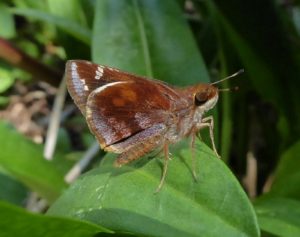
Given these concerns we decided to make our solstice ceremony one to welcome back the pollinators and to hold it during National Pollinator Week (June 22-28 this year). We envisioned the event as a prayer for the healing of our insect kin and our complex relationship to them. We wanted to create an invitation, calling them to come to the sanctuary of this healthy habitat. We desired to affirm that even when we feel alone, with necessary social distancing, we are not alone in the natural world.

Ceremony to Welcome Back the Pollinators
Gathering in the moss garden, our small group of masked, socially distancing friends start with a brief check-in, expressing what we are grateful for and sharing our hopes and intentions for healing from Covid-19, both personally and collectively. We acknowledge that even though coping with the pandemic has rightfully taken precedence over concerns about climate change and loss of biodiversity, these are all forms of disease, and they are all linked. The natural world is suffering, too, and calls for our attention. Covid-19 has made it very clear that if the animals are not healthy the people cannot be healthy.
We have prepared for the gathering by fashioning a collective altar on the moss.
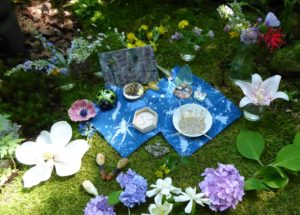
We begin the ceremony by orienting ourselves to the powers of the seven sacred Directions and purifying ourselves with the Elements, earth, air, fire, and water. One of us reads an opening poem by Paulann Peterson:
A Sacrament
Become that high priest,
the bee. Drone your way
from one fragrant
temple to another, nosing
into each altar. Drink
what’s divine –
and while you’re there,
let some of the sacred
cling to your limbs.
Wherever you go
leave a small trail
of its golden crumbs.
In your wake
the world unfolds
its rapture, the fruit
of its blooming.
Rooms in your house
fill with that sweetness
your body both
makes and eats.
We extend a prayer for all those who have suffered and died from the pandemic, particularly the Navajo, Hopi and so many other Native Americans, who, along with other marginalized people, have been especially hard hit by Covid-19. With gratitude we invoke the beautiful, well-known Navajo magic formula for subduing the anger of enemies and instilling peace, as symbolized by pollen:
Put your feet down with pollen.
Put your hands down with pollen.
Put your head down with pollen.
Then your feet are pollen; your hands are pollen;
your body is pollen; your mind is pollen; your voice is pollen.
The trail is beautiful. Be still.4
Then we spend some quiet solo time walking the garden trail. Many cultures begin a journey by invoking an enveloping protection. So, too, we affirm the spiritual support that is all around us as we walk in beauty. Again, with gratitude, from the Navajo:
I walk with beauty before me. I walk with beauty behind me. I walk with beauty below me. I walk with beauty above me. I walk with beauty all around me.
As we walk in a sacred manner we make offerings of song:
May I walk in beauty, may I walk in peace. May I walk in beauty, may I walk in peace. All, all my relations. All, all my relations.
Walking mindfully, we pause and bow as we gather flowers into baskets, singing the words of Thich Nhat Hanh teaching us to see the sacred in every being:
May I take peaceful steps upon the Earth. May I take peaceful steps upon the Earth. I bow to you, a flower. I bow to you, a flower.
Much of the potency of ritual depends upon the incorporation of what Jung saw as two complementary poles of the psyche, instinct and image, instinct being the life of the body, image being the life of the soul. So we walk, moving our instinctual animal bodies, singing to the soulful image of Flower as we gather flowers with gratitude, bowing to acknowledge the sacred in each one. The Butterfly is an image symbolic of the soul. As we call to the butterflies to return so, too, we call to our own souls to return to the Garden to heal ourselves and our relationship with nature.
Rather than making a large mandala together, we keep our Covid-19 distance and make individual mandalas on the canvas of moss with our gathered flowers and petals. We imagine male stamens ripe with potent pollen, female pistils open and receptive, ovaries waiting to become vessels for the embryos that will form as the sperm come down through the pollen tubes and enter them. So very like our own sexual bodies. But, unlike our intercourse, flower sex requires help. Flowers need the various insects to bring the pollen from male parts to female parts in this communal orgy of fertility. The insects get nourished, in turn, by the reciprocal gifts of sweet nectar and pollen. When our colorful flower mandalas are complete we scatter trails of pollen to connect them.
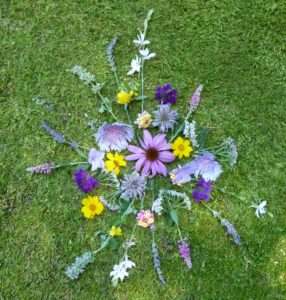
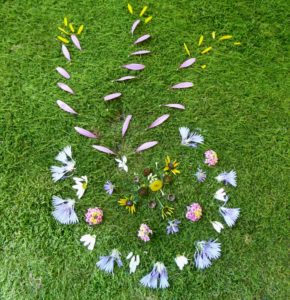
While circling the flower images, we speak aloud potent words of appreciation and gratitude, words of praise and blessing to honor, to call, to coax, to entice the pollinators to see the beauty of their flower partners and come, come to the dance. We challenge ourselves to make our songs as visceral as life itself. We disclose the voices of flowers calling out, “Come probe our brazen shapes and textures. Come behold our flagrant colors and designs. Come smell our shameless perfumes and spicy aromas. Come drink your fill of our sweetness and gather on your bodies our sustaining substances.”
We accentuate the cadence of each phrase with rhythmic sound — tinkling high chimes, resonant low chimes, bells, rattles, click-sticks— weaving a sensuous sound-spell of words and music, joining flowers and insects and ourselves as we plants, animals, and human kin, all call to those of earth and air to come perform the spell-binding magic of summertime.
Because we are participating in the deeply sensuous relationship of pistils and stamens and pollen and insects, we celebrate with all of our senses: we see and smell the flowers; we touch the petals as we pick them and the moss as we arrange them; we hear the reverberating sounds of words and song and the music of bees; we taste a confection of seeds infused with honey. Finishing the ceremony with an act of service, we plant a new swamp milkweed for the monarchs at the edge of the pond.
Our passionate plea for pollen, peace, please: May we honor our beautiful differences and create a dance of healing together with all people and all other forms of life.
Solstice Silphium Sketch
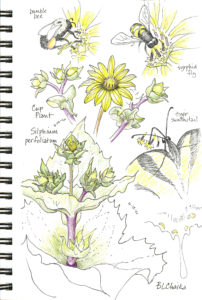
Text, drawing, and photos (C) 2020 Betty Lou Chaika. All photos taken in Temenos Garden Sanctuary
Notes:
1.For an excellent article on the link between white supremacy and environmental destruction see:
2. Xerces, the premier organization for insect conservation, wrote in a Dec. 2019 blog called Insect Apocalypse? What is Really Happening; Why it Matters . . .
“Among bumble bees, 28 percent of species in North America are considered threatened . . . similar trends: NatureServe assessed 636 butterfly species in the United States and Canada and found 19 percent at risk of extinction.”
www.xerces.org › blog › insect-apocalypse-what-is-real…
www.nationalgregraphic.com/animals/2019/02 a new study suggests that 40% of insect species are in decline both in abundance and diversity.
3. David Quammen predicted the pandemic in 2012 when he who wrote in his book Spillover that our disrupting of wild ecosystems in our greed for more resources would cause animals to be stressed and shed viruses that could well cross over to infect humans.
4. The Book of the Navajo, Raymond Friday Locke, p 108.
riverdave
thank you bl for this essay, very inspiring. my favorite pollination ceremony is to gather pine pollen around april 1st and make a pint of tincture. i let it brew and shake it every day till earth day on 4/22. on that day i strain it and start taking it every morning for about three months till i finish it. it is such a sweet, revitalizing substance that enables me to easily slip into the flow of spring, the celebration of sexuality and the renewal of life … rd
Betty Lou Chaika
rd, you’re very welcome, as a naturalist who yourself has asked where all the butterflies are. I’ve heard you talk about your pine pollen elixir, and it’s nice to hear the detailed description, so I can imagine the daily progression of your spring renewal.
ann loomis
What beautiful photos you have to go along with your colorful story! I so enjoyed reading it and very much appreciate your mentioning St. John’s Feast Day at Midsummer. Just think of how that feast day is hardly known in contrast to the winter solstice/Christmas six months later. This says something about our culture’s fear of the dark and may even be at the root of our perceived “white (or light-skinned) supremacy.”
Betty Lou Chaika
Ann, I’d love to hear more of your thoughts about the link between Midsummer, fear of the dark, and white supremacy.
Marie
Your essay is wonderful and full of hope, much needed these days! Thank you for sharing your ceremony.
Betty Lou Chaika
Marie, thanks for reading. Yes, we need hopeful thoughts and hopeful actions!
Janice Tasnim
Betty! I love this so much, as you show me the ways you have articulated, deepened and enhanced this sacred ritual through co-creation with nature.
May I share this piece in facebook, I have many friends who would appreciate this. Abundant green blessings to you and all the kin in your garden.
🌿💦🌸💦🌿. Tasnim Janice
Betty Lou Chaika
Tasnim Janice, your enthusiastic response makes me feel like you joined with us in the ritual, you and all your green kin! Yes, feel free to share it! With love, Hakima BL
ann loomis
The summer solstice on June 21 is the longest and lightest day of the year, and it takes about three or four days after that to notice the lessening of the light. Therefore, St. John’s Feast Day on June 24 represents the time of year that we start to notice it. In our culture, we don’t generally welcome the darker and shorter days; hence, we don’t have a need to celebrate St. John’s Day.
The winter solstice on December 21 is the shortest and darkest day of the year, and it takes about three or four days after that to notice the increasing light. Therefore, Christmas Day on Dec. 25 represents the time of year that we start to notice it. In our culture, we generally welcome the lighter and longer days; hence, the celebration of the coming of the light at Christmas. The message seems to be: “light good, dark bad.” Could this disdain of the dark be at the root of our projection on dark skin people?
Betty Lou Chaika
Thanks, Ann, for you enlightening thoughts on this colonialist culture’s preference for light over dark. Yes, we eagerly welcome the start of longer days after Winter Solstice, but we don’t look forward to the progression of darker days after Summer Solstice. I wonder if those who celebrate St. John’s Feast Day also tend to celebrate darkness more, in general.
ann loomis
Yes, I’d guess that they do. This also has to do with honoring the feminine and Mother Earth.
Betty Lou Chaika
Yes, we certainly know European Catholics venerate the Black Madonna!
Sandra
Dear Friend, your powerful and beautiful words, so evocative, have entered my heart and mind this summer evening. Thank you so much for your creative celebration, a call for communion among ALL species. Deep appreciation for your poignant call to the pollinators on whom so much of our earth life depends. And much gratitude for the micro-Eden you continually create in Temenos Garden Sanctuary. The celebration, the calls, the Sanctuary, they are living and real blessings that radiate widely. Thank you. With love.
Betty Lou Chaika
Thanks, Sandra. I can imagine you adding your own beautiful voice from the flowers in your own exquisite garden to the call for the butterflies to return. Let us know who shows up!
Sandra
Sharing some of my spring garden 2020 photos here: https://sandrabrooks-mathers.smugmug.com/Garden-Spring-2020/. A few but not many pollinators appear. Other images show beautiful plants and trees awaiting their lovers, the pollinators. I join your call to them, Betty Lou, and the most fecund call of the flowers!
Betty Lou Chaika
Ah, thanks Sandra, what a treasure-trove of gorgeousness! Looks like you had swallowtails early on azaleas and vibernums. Love the carpenter bees on columbine and Itea, the honey bee on iris, and the assassin bug on daylily!
Barb Stenross
What a lovely ceremony at this challenging time. I love how the flowers are calling out to their consorts, the pollinators, awaiting their arrival, longing for their touch. The photos are also magical, and the mandalas, amazing. I had to look up “temenos.” How fitting a name for this sanctuary. May it be filled with loving exchange!
Betty Lou Chaika
Yes, Barb, I can see the flowers in your garden reaching up and calling out, too, to the bees and butterflies to come taste the nectar and touch the pollen. It is indeed life’s loving exchange, as you say.
Laurel
Thank you dear Betty Lou for sharing this personal magic for honoring the pollinators and the flowers. These days I am well aware of how much we all need each other and all of nature and all the beings.
Blessings on you good work and hope to see you soon 🙂
Laurel
Betty Lou Chaika
Laurel, thank you for your blessings. May your work thrive, too. Yes, I hope one good thing that comes out of Covid-19 is peoples’ reconnection with nature. I would love for you to come for a visit to the garden!
Beth
BL, thank you for sharing your thoughts and photos. They are always inspirational! I especially appreciated the thoughts on hope…..choosing to be hopeful as an act of will. We certainly need to do that in these turbulent times. I also had not heard about the connection of St. John’s Wort with Midsummer . Thank you!
In addition to the bees and butterflies, I have noticed that fireflies are diminishing. I don’t know whether they are pollinators; I enjoy watching them. It is a beautiful sight and a link to happy memories from my childhood and that of my children and grandchildren.
So glad to hear you and yours are healthy! May it be forever so.
Bright blessings!
Beth
Betty Lou Chaika
Hi Beth, thanks for reading! One can only be inspired if one is open to being so. I remember your enthusiasm for cross-quarter ceremonies. You let yourself be inspired and enthusiastic. Maybe you choose these, perhaps for your soul’s sake, perhaps for the sake of the world’s soul.
I don’t think fireflies are recognized as pollinators, but they are certainly insects who are declining. One reason is because all night street and porch lights confuse their signalling. Hold onto those precious firefly memories. I believe the natural world feels our love.
Good health to you and your family, too.
William Murray
BL, thanks for the beautiful pictures and your wisdom. This is quite a creative spectacle . Blessings, Bill Murray
Betty Lou Chaika
Well, hey Bill! Thanks for reading and letting me know your encouraging response!
Laurie Lindgren
Hakima,
I am so moved by your description of the ritual in terms of all the senses, and I could almost feel as if I were there! I am certain that your intentions, creations, sounds, and words have enticed many more pollinators to the glory of the Flower. May all of our instincts and souls unite in sacred ecstasy in order for a more perfect union to manifest abundance on the fruited plain!
Thank you from my core for your taking upon yourself this mantle of caring and love and manifestation for our entire ecological community!
Love,
Hayat
Betty Lou Chaika
Thanks, Laurie, for bringing your own sensual body and soul to the ceremony. Yes, everyone can enlist their senses in supporting the call of the flowers to the insects to fly to the feast. As a plant medicine person your intimacy with the plant people is a constant call for their health and well-being. I wonder if you have a favorite Solstice flower or Midsummer plant.
Marj Marie
Every word is lovely. I am especially glad you added the drawing. You are a talented storyteller and artist, thank you for taking time to share! Your work is beyond wonderful! The photos are breathtaking, and I truly love the flower mandalas. I love you very much, and I feel that the pollinators do as well. Thank you for living so very intentionally. Marj Marie
Betty Lou Chaika
Marj Marie, it’s hard for me to swallow so many loving words in one gulp. I receive them with gratitude, such sweet nectar from your big blooming heart! Dear one, I look forward to the time when we can celebrate in community-wide ceremony together again.
Laurie Lindgren
I love your new drawing. Just looking at it is healing for my heart and mind in many ways. I love the yellow and purple together too.
My favorite right now is Evening Primrose with its yellow flower. I have a large stand in the front yard that reseeded itself from a few years ago when I started it from purchased seed. I like the clear ascendancy in the bed coupled with its more private blooming schedule.
Betty Lou Chaika
Glad you like the drawing, Laurie. Yes it felt good to once again weave words, drawing, and photos together in one story. Oh, blessed herbalist, do you make medicine with Evening Primrose? We will need to see who are its favorite pollinators. Oh, yeah, moths, hummingbird moths, bees. I love this study of Evening Primrose in which scientists discover that when the flowers sense the wing-beats of bees and hear the buzzing of honeybees they temporarily increase the sweetness of the nectar: https://www.nationalgeographic.com/science/2019/01/flowers-can-hear-bees-and-make-their-nectar-sweeter/
Nancy Corson Carter
Dear Betty,
What a cornucopia of loving attention to our beautiful but endangered world spills forth, a brightness in my day! Your photos, your words, the rituals themselves are to me a blessed reminder of our interconnections. I am carefully watching our garden this summer, the flux of blossoms and insects (and a few others)–the last daylily blooming today in the first season of the planting we made 2 years ago, a few honeybees, a fairly robust showing of fireflies to brighten our just-after-twilight, but the scarcity of butterflies; a little turtle in our driveway appearing and then disappearing like an cryptic messenger, a gorgeous summer tanager hanging out in the neighborhood. Reading all the replies above, I am cheered by the ways your work brightens so many lives, gives hope & courage in this daunting time. I thank you for that. And I cheer your wonderful drawing–please let this be the opening for much more! Love, Peace, Joy, Nancy
Betty Lou Chaika
Nancy, you who gives so much loving, poetic attention to the natural world yourself, thanks so much for your own care and concern for the critters. Do you have mountain mint? It is an incredible honey bee magnet again this year. Hope and courage are certainly what we need now. Gratitude for your encouragement. May brightness surround you every day.
Diantha Rau
Well, dear one, as always I feed well on your words and experiences through the generous gifts of knowledge and language you offer (as well as the beauty you wrap it in, as every other flower does). But this time I am nearly choked up with gratitude and inspiration, so comprehensive is your sharing here, touching on so many of the ways our plant and insect relatives inform and perpetuate all life, complete with photos to bring us in close. My gratitude is deep, my closeness to the Mother revitalized, and my inspiration is fired up again, to nurture native plants here on our prime land for it, despite my physical limitations. Thank you so much. I will send this also to Megisikwe, a plant medicine keeper who will adore it as I do. Thank you for being all that you are, and David too. Much Love, Diantha
Betty Lou Chaika
Diantha, thank you for your devotion to Mother Earth and all of her children. I appreciate your encouraging enthusiasm for the story. I’m glad it inspires you as you add to your own native plant gardens. I would be glad to consult with you on plantings, if you’d like. May we all be surrounded by our plant and animal kin in a great Circle of Belonging.